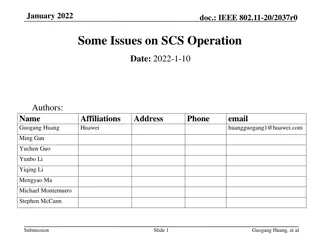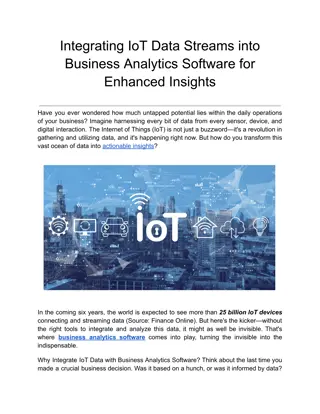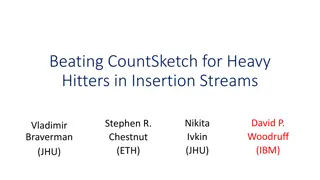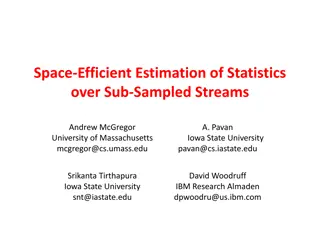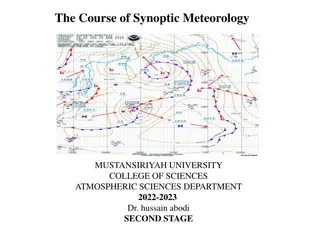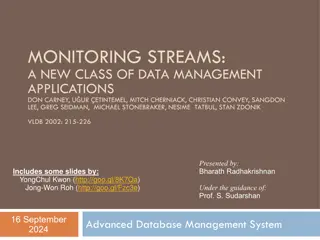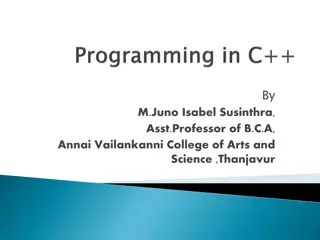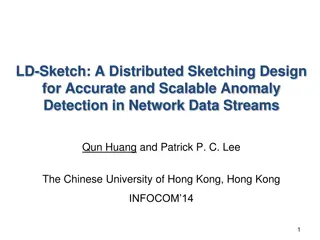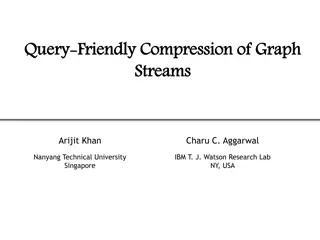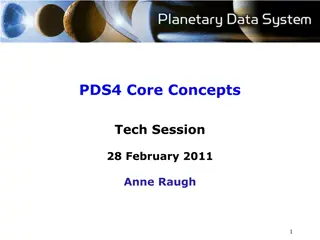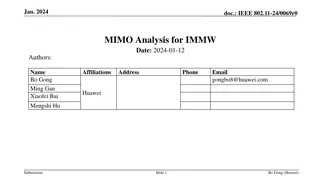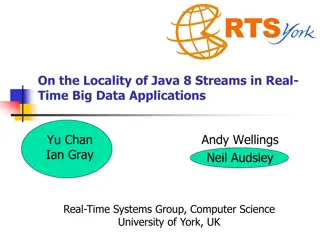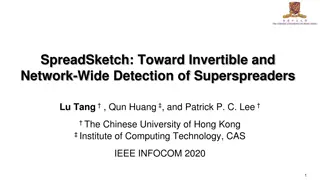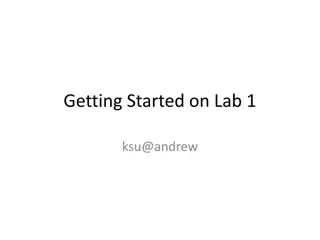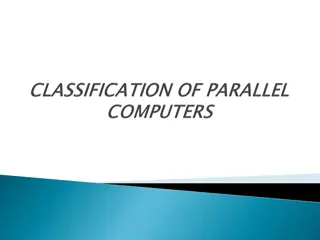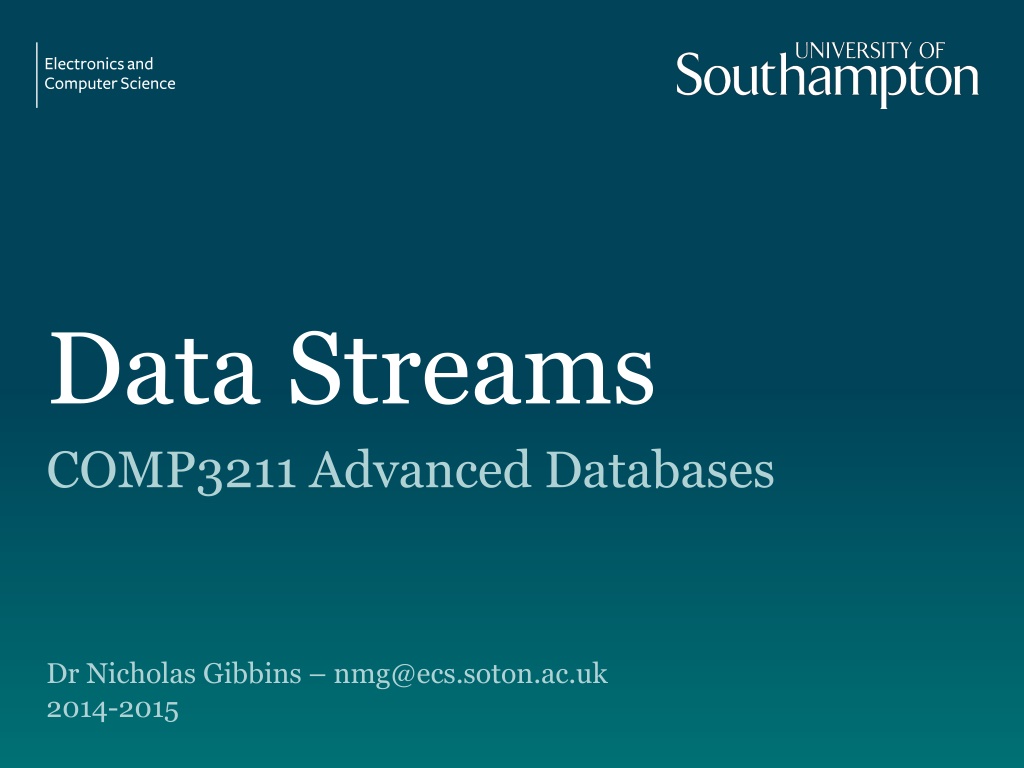
Understanding Data Streams in Advanced Databases
This content explores the transition from traditional database systems to data streams, highlighting the unique requirements of real-time data applications. It delves into the concept of continuous queries, application domains, and examples such as MIDAS. The discussion covers transactional data streams, various application scenarios like network monitoring, and the differences between one-time and continuous queries. Additionally, it touches upon database management systems and query processing.
Uploaded on | 0 Views
Download Presentation

Please find below an Image/Link to download the presentation.
The content on the website is provided AS IS for your information and personal use only. It may not be sold, licensed, or shared on other websites without obtaining consent from the author. If you encounter any issues during the download, it is possible that the publisher has removed the file from their server.
You are allowed to download the files provided on this website for personal or commercial use, subject to the condition that they are used lawfully. All files are the property of their respective owners.
The content on the website is provided AS IS for your information and personal use only. It may not be sold, licensed, or shared on other websites without obtaining consent from the author.
E N D
Presentation Transcript
Data Streams COMP3211 Advanced Databases Dr Nicholas Gibbins nmg@ecs.soton.ac.uk 2014-2015
From Databases to Data Streams Traditional DBMS makes several assumptions: persistent data storage relatively static records (typically) no predefined notion of time complex one-off queries 2
From Databases to Data Streams Some applications have very different requirements: data arrives in real-time data is ordered (implicitly by arrival time or explicitly by timestamp) too much data to store! data never stops coming ongoing analysis of rapidly changing data 3
Application Domains Network monitoring and traffic engineering Sensor networks, RFID tags Telecommunications call records Financial applications Web logs and click-streams Manufacturing processes 5
Data Streams A (potentially unbounded) sequence of tuples Transactional data streams: log interactions between entities Credit card: purchases by consumers from merchants Telecommunications: phone calls by callers to dialed parties Web: accesses by clients of resources at servers Measurement data streams: monitor evolution of entity states Sensor networks: physical phenomena, road traffic IP network: traffic at router interfaces Earth climate: temperature, moisture at weather stations 6
One-Time versus Continuous Queries One-time queries Run once to completion over the current data set Continuous queries Issued once and then continuously evaluated over a data stream Notify me when the temperature drops below X Tell me when prices of stock Y > 300 7
Database Management System query results query processor stored data on disk 8
Data Stream Management System (DSMS) continuous query stream of results data streams data streams query processor 9
DBMS versus DSMS DBMS Persistent relations (relatively static, stored) DSMS Transient streams (on-line analysis) One-time queries Continuous queries (CQs) Random access Sequential access Bounded main memory Unbounded disk store Only current state matters Historical data is important 10
DBMS versus DSMS DBMS No real-time services DSMS Real-time requirements Relatively low update rate Possibly multi-GB arrival rate Data at any granularity Data at fine granularity Assume precise data Data stale/imprecise Access plan determined by query processor, physical DB design Unpredictable/variable data arrival and characteristics 11
A Motivation for Stream Processing Over the past twenty-five years: CPU performance has increased by a factor of >1,000,000 Typical RAM capacity increased by a factor of >1,000,000 RAM access time has decreased by a factor of >50,000 Typical HD capacity increased by a factor of >50,000 HD access time has decreased by a factor of ~10 12
Architectural Issues DBMS Resource (memory, disk, per- tuple computation) rich DSMS Resource (memory, per-tuple computation) limited Extremely sophisticated query processing, analysis Reasonably complex, near real time, query processing Useful to audit query results of data stream systems. Useful to identify what data to populate in database Query Evaluation: Arbitrary Query Evaluation: One pass Query Plan: Fixed. Query Plan: Adaptive 13
Query Processing 14
Example: Continuous Query Language Queries produce/refer to relations and streams Based on SQL, with the addition of: Streams as new data type Continuous instead of one-time semantics Windows on streams (derived from SQL-99) Sampling on streams (basic) 15
Query Processing Construct query plan based on relational operators, as in an RDBMS Selection Projection Join Aggregation (group by) Combine plans from continuous queries (reduce redundancy) Stream tuples through the resulting network of operators 16
Tuple-at-a-time Operators Evaluation requires consideration of only one tuple at a time Selection and projection input stream output stream op 17
Full Relation Operators Some full relation operators can work on a tuple at a time Count, sum, average, max, min (even with group by) (order by, however, can t) input stream output stream op accumulator 18
Full Relation Operators Other (binary) full relation operators can t Intersection, difference, product, join (union, however, can be evaluated tuple-by-tuple) input stream output stream op input stream 19
Full Relation Operators May block when applied to streams no output until entire input seen, but streams are unbounded joins may need to join tuples that are arbitrarily far apart input stream output stream op input stream 20
Relation/Stream Translation Some relational operators can work directly on streams Selection, projection, union, some aggregates Some relational operators need to work on relations Join, product, difference, intersection, other aggregates Stream-to-relation operators Windows Relation-to-stream operators Istream, Dstream, Rstream 21
Windows Mechanism for extracting a finite relation (synopsis) from an infinite stream Various window proposals for restricting operator scope. Windows based on ordering attribute (e.g. last 5 minutes of tuples) Windows based on tuple counts (e.g. last 1000 tuples) Windows based on explicit markers (e.g. punctuations) Variants (e.g., partitioning tuples in a window) Various window behaviours Sliding, tumbling 22
Sliding Windows data stream windows time t0 t1 t2 t3 t4 t-4 t-3 t-2 t-1 23
Tumbling Windows data stream windows time t0 t1 t2 t3 t4 t-4 t-3 t-2 t-1 24
Join Evaluation Consider a stream-based join operation: a conventional join over a pair of windows on the input streams outputs a stream of tuples joined from the input streams input stream input stream output stream 25
Scalability and Completeness DBMS deals with finite relations query evaluation should produce all results for a given query DSMS deals with unbounded data streams may not be possible to return all results for a given query trade-off between resource use and completeness of result set size of buffers used for windows is one example of a parameter that affects resource use and completeness can further reduce resource use by randomly sampling from streams 26
Relation-to-Stream Operators Insert Stream (Istream) Whenever a tuple is inserted into the relation, emit it on the stream Delete Stream (Dstream) Whenever a tuple is deleted from the relation, emit it on the stream Relation Stream (Rstream) At every time instant, emit every tuple in relation on the stream 27
Example CQL Query SELECT Istream(*) FROM S [rows unbounded] WHERE S.A > 10 S is converted into a relation (of unbounded size!) Resulting relation is converted back to a stream via Istream 28
Example CQL Query SELECT * FROM S WHERE S.A > 10 S is a stream query plan involves only selection, so window is now unnecessary 29
Example CQL Query SELECT * FROM S1 [rows 1000], S2 [range 2 minutes] WHERE S1.A = S2.A AND S1.A > 10 Windows specified on streams Tuple-based sliding window [rows 1000] Time-based sliding window [range 2 minutes] 30
Example CQL Query SELECT Rstream(S.A, R.B) FROM S [now], R WHERE S.A = R.A Query probes a stored table R based on each tuple in stream S and streams the result [now] time-based sliding window containing tuples received in last time step 31
Query Optimisation Traditionally relation cardinalities used in query optimiser Minimize the size of intermediate results. Problematic in a streaming environment All streams are unbounded = infinite size! 32
Query Optimisation Need novel optimisation objectives that are relevant when input sources are streams Stream rate based (e.g. NiagaraCQ) Resource-based (e.g. STREAM) QoS based (e.g. Aurora) Continuous adaptive optimisation 33
Notable DSMS Projects Aurora, Borealis (Brown/MIT) sensor monitoring Niagara (OGI/Wisconsin) Internet XML databases OpenCQ (Georgia) triggers, incr. view maintenance STREAM (Stanford) general-purpose DSMS Telegraph (Berkeley) adaptive engine for sensors 34
Further Reading A. Arasu et al. STREAM: The Stanford Data Stream Management System, Technical Report, Stanford InfoLab, 2004. A. Arasu, S. Babu and J. Widom. The CQL continuous query language: semantic foundations and query execution, The VLDB Journal, 15(2), 121-142, 2006. M. Cherniack et al, Scalable Distributed Stream Processing, Proceedings of the First Biennial Conference on Innovative Data Systems Research (CIDR 2003), 2003. 35

